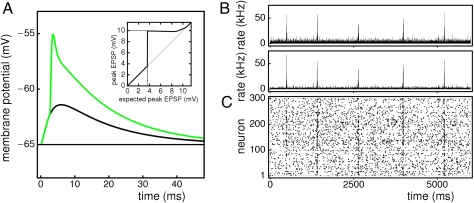Fig. 2.
Supralinear dendritic enhancement of inputs within a finite temporal interaction window leads to spontaneous, intermittent increases in the network activity. (A) Comparison of the depolarizations caused by several simultaneous inputs in a conventional neuron (black) and in a neuron with supralinear dendritic interactions (model 2; green). (Inset) Modulation function σ. (B and C) The dynamics of a network incorporating supralinear dendritic interactions. (B) The spike rate (bin size 1 ms) of the inhibitory (Upper) and of the excitatory (Lower) neuron population. (C) The spiking activity of 300 of the excitatory neurons. The dynamics are characterized by irregular spiking interrupted by spontaneous, intermittent increases of activity involving both the inhibitory and the excitatory neuron population. During such an event a larger fraction (about one third) of the neurons in the excitatory population sends a spike, and almost every inhibitory neuron sends usually several spikes. The event around t = 1,400 ms is depicted in Fig. 3A.

